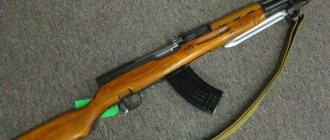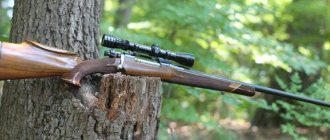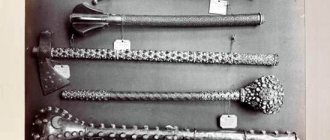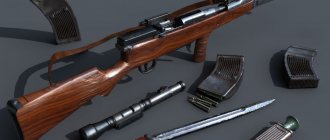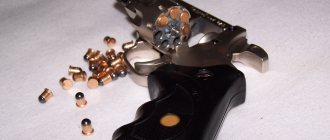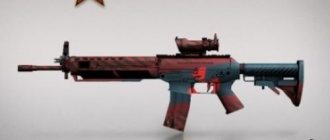CALIBER 12/89 IN RUSSIA
(“ROG” No. 31 (419) July 31 - August 6, 2002)
Weapons of 12/89 caliber appeared in Russia long before the appearance of the MP-153 shotgun with an 89 mm chamber. First of all, these were products from Benelli (Italy) and Browning (Belgium), such as the semi-automatic Benelli Super Black Eagle, Browning Gold Hunter 3.5 and the Benelli Nova pump-action shotgun. Apparently, this is where they decided to end the experiment on selling imported weapons with an 89 mm chamber. And it’s no coincidence, because There has not been, and still is not, high-quality ammunition for this weapon at an affordable price. The attempt to have weapons chambered for 89 mm in Russia is reminiscent of Germany's attempt to create the largest Maus tank. For some reason, some people think that purchasing a gun with an 89 mm chamber will solve all the problems associated with prey hunting for goose, wood grouse, etc. In Russia, the problems of goose hunting are solved in other ways, and not with a gun with an 89 mm chamber. To understand this, you just need to understand where the problem of creating the 12/89 cartridge came from. This problem primarily appeared in the USA. American hunters were unobtrusively asked by their legislators to shoot geese and turkey with steel shot for environmental reasons. It is clear that the use of steel shot, especially larger ones, requires solving certain technical problems. This is the creation of special wads-containers that can reliably protect the bore from the effects of steel shot, this is the creation of special gunpowders that can provide proper internal and external ballistics of the shot, the creation of a primer that can work effectively with this gunpowder. After all, the pressure developed by a cartridge in an 89 mm chamber with a 45 g load of steel shot is 96 MPa. All these problems Federal Cartridge Co. began solving in 1987. According to the company's new product development manager, Bob Kramer, many experiments were conducted with brands of gunpowder, but none of them gave satisfactory results. Federal eventually had to create a new powder for the 12/89. It must be remembered that we are talking about ammunition with steel shot. In Russia, the only organization that has been working, and for a long time, on the problem of using steel shot, is Research and Production. Thanks to a large amount of research conducted, and the personal enthusiasm of Sergei Georgievich Mitichkin, Chairman of the Board of Directors, ammunition has been created that allows you to shoot game with small and large steel shot, shot weights up to 30 g using Sunar gunpowder, with a 70 mm cartridge case. The main thing is that a container has been created, the material of which allows you to reliably protect the barrel bore. But Sunar gunpowder is a fast-burning gunpowder, it cannot be used for weighing large steel shot in 45 g. A container that is suitable for using small steel shot is completely unsuitable for large steel shot. And the difference here is not only in the size of the container, large steel shot must be oriented in a certain way in the container. Of course, you can create a container for a steel shot projectile weighing 45 g, using Sunar-Magnum gunpowder. It must be remembered that the task of reliably hitting a target such as a goose at a distance of 50 m can only be solved by increasing the number of steel shot and the mass of the projectile, and not the initial speed. It is pointless to increase the initial speed of the shot to high values when shooting at a distance of 50 m; this will lead to a decrease in such an indicator of the shot as the coefficient of concentration of the shot towards the center of the target, which is very important when shooting shot at extreme distances. Placing large steel shot (diameter 00;000) in a thick-walled plastic container when using Sunar-Magnum gunpowder can lead to the fact that the case will not be rolled in the “star” way, but in the usual way. The overall length of the cartridge will increase, and problems will arise with feeding it from the under-barrel magazine in imported semi-automatic and pump-action pumps. It may be necessary to create a new powder that takes up less volume in the case. It is known that a steel shot projectile is practically not deformed at the initial moment of the shot. How will Sunar-Magnum gunpowder behave in this situation, what will the pressure be, and how will the intra-ballistic process inside the barrel proceed? In a word, there are problems, and considerable ones. It will not be possible to solve them quickly, and why should they, because in Russia, thank God, no one forbade shooting with lead shot. Maybe someday they will ban it, I don’t think it will be in the near future; During this time, perhaps, NPF Yulia will create reliable Magnum class ammunition with steel shot. What does our ammunition industry now offer to owners of 12/89 shotguns? The choice, frankly speaking, is small. Of the domestic manufacturers who are concerned about the problem of owners of 12/89 shotguns, let’s name two factories: the Krasnozavodsk Chemical Plant, which produces Record cartridges, and the plant named after. Sergo Ordzhonikidze, producing Pozis cartridges. Owners of MP-153 shotguns of 12/89 caliber are mainly trying to purchase ammunition from these factories. But both cartridges, “Leader” 12/89 and “Pozis” 12/89, are loaded with lead shot. There are some questions in this regard. If these cartridges use 63-64 g of lead shot, typical for the 12/89 caliber, then what kind of gunpowder is used in the ammunition? Is it really some kind of import? It’s unlikely, since the price of the cartridge speaks for itself. Then, apparently, “Sunar-Magnum”, but this gunpowder is created for shot loads, in extreme cases, 46-55 g. Camphor is used as a phlegmatizer in gunpowder. Probably the specialists from Federal Cartridge Co. they just don’t know anything about camphor, they’re sitting there in the USA, and out of all the abundance of gunpowders for Magnum cartridges, they couldn’t choose anything for the 12/89 caliber. Lead shot in 12/89 ammunition is usually copper-plated; Apparently, such a shot is needed, at least, the creators of the Winchester XX Magnum ammunition think so. If Sunar-Magnum gunpowder is used, then for a 42 g shot projectile you need 2.2 g, therefore, for a 63-64 g projectile, even more so. What kind of wad container should it be, and most importantly, what shock-absorbing qualities should it have? After all, it is necessary to place both a charge of gunpowder and a shot shell in 63-64. How in this case is the issue of reducing the deformation of lead shot at the initial moment of the shot solved? I don’t want to think about the fact that wood fiber or felt wads are used in such ammunition. What primer is used? There are many questions for the patron. The main thing is how all these issues can be resolved in such a short time and with high quality. The price of ammunition is encouraging, but questions remain; the price itself makes you think. The MP-153 12/89 shotgun has a mass of 3.6 kg, an automatic gas system, but what will the recoil be when firing cartridges with a shot load of 63-64 g? It seems that the return will be unpleasant. After all, 63-64 g of shot is a 10-gauge sample, but in 10-gauge the intra-ballistic processes proceed somewhat differently. And weapons for such shot loads have a mass of 4.5 to 4.9 kg. Of course, a 12/89 weapon will provide quite acceptable recoil when firing cartridges with a 45 g load of steel shot, but not lead in 63-64. Everyone has known about this in the USA for a long time, for this they produce the 10th caliber. If in the considered ammunition “Leader” 12/89 and “Pozis” 12/89 the shot weight is 50-55 g, then why use an 89 mm cartridge case, 76 mm is enough. In a word, 12/89 weapons are generally not needed in Russia before the arrival of magnum-class ammunition with steel shot on the market; 12/76 will suffice. And as the world experience in creating ammunition shows, there are other ways to solve the problem of confidently hitting a goose at a distance of 50-60 m. You can take a closer look at the experience of Italian specialists from the Zanoletti company (Walter Zanoletti) in creating new ammunition; a very interesting idea, the main thing is that a 70 mm sleeve is used with a shot load of 50-52 g, the sleeve is rolled in an ordinary manner. But for confident shooting of geese, a different approach is needed. The main thing is not to interfere, so that there is a desire to understand the essence and rules of this hunt, to learn how to use a decoy well, of course, you need to be a good shooter. As for the cartridges for this hunt, for us, ordinary Russian hunters, ordinary starch will solve all our problems for a long time. When cartridges appear that will be capable of confidently hitting a goose at 50-60 m without starch, then we will shoot them; I would like their price to be no more than self-equipped ones. I personally have never held such industrially produced 12-gauge cartridges at a reasonable price, for any chamber.
Dmitry Kopaev
Main features of 16 gauge
During the Soviet years, the 16th gauge competed with the 12th for a long time and was considered in many ways even better. However, over time, weapons companies realized that guns with a barrel diameter of 16.8 millimeters were not very popular, so their production began to decline. One of the brightest impetuses for this was the story of the IZH-57, a 16-caliber modification of the legendary double-barreled shotgun IZH-54. During its entire existence, no more than 20 thousand copies of this model were sold.
However, one should not think that the time of the 16-gauge has passed and hunters do not choose such a weapon as a faithful ally. To this day, in gun stores you can find interesting models that perform well on the hunt. The main difference with the 12 gauge is that the 16 gauge is more highly specialized. Such a gun is used mainly for hunting waterfowl, as well as shooting fur-bearing animals.
16 gauge is typically used for small game hunting.
As for the main features, they look something like this:
- Weapon weight. Compared to 12-gauge double-barreled shotguns, models with a diameter of 16.8 millimeters are significantly lighter because the barrel is smaller. It is convenient to move with such a weapon, and the hunter gains additional maneuverability when shooting.
- Recoil. One of the undeniable advantages of a 16-gauge shotgun is that it has much better ergonomics due to lower shot power and a relatively small amount of gunpowder (up to 3 grams) and shot (up to 34 grams).
- Assortment of guns. Despite the fact that you can still find samples of 16-caliber smoothbore weapons in gun stores, manufacturing companies are extremely reluctant to produce new models due to their low popularity.
- Availability of ammunition. Many hunters complain that they have to wait weeks for 16-gauge ammunition to arrive at their local gun store. And considering that some guns only shoot branded ammunition, the problem only gets worse.
- Variety of cartridges. Despite the fact that the 16-gauge can be loaded with a bullet or buckshot, in practice such ammunition is used extremely rarely. After all, the main purpose of this gun is to shoot shot loads from 23 to 34 grams.
However, supporters of the 16-gauge are right that such a weapon is much better suited for hunting game birds. The accuracy of the battle remains at 55% (chok) and 45% (poluchok) when shooting from a distance of up to 50 meters. Well, at long distances it is the large spread of shot that allows you to shoot game birds. And on a fur-bearing animal there will not be as many wounds as from a shot from a 12-gauge. The most important thing is to choose the appropriate shot number and the optimal amount of gunpowder.
A 16 gauge shotgun is effective at short range
Pros and cons of 16 gauge
Let’s highlight the main advantages and disadvantages of 16-gauge in a table to make it easier to form an objective opinion:
| Advantages | Flaws |
| Low recoil | Low shot power |
| Small weight of weapons | Poor combat accuracy |
| Poor range of guns | |
| Monotony of cartridges | |
| Ammunition shortage |
As you can see, the situation is completely opposite. However, does this mean that the 16 gauge is much worse suited for hunting? To some extent, yes. But if hunting with a 16-gauge shotgun is carried out on the right game, then some of the shortcomings (lack of power and accuracy) simply lose their relevance. The only problem that remains is with choosing a gun and ammunition, which is partially solved by the ability to order everything you need via the Internet. If you like to buy everything in a store, then there’s nothing you can do about it - they have a really small assortment.
One last thing: is a 16-gauge shotgun suitable for the beginning shooter? Yes, and much better than the 12 gauge, but provided that the hunter does not switch to a larger option in the future. Otherwise, it will take quite a long time to get used to the recoil that appears, and you will need to acquire all shooting skills again. But if a hunter does not strive to become a professional, but only occasionally goes out to the river for ducks, then learning to shoot accurately at the target will be much faster. So when choosing a weapon, you should also look to the future.
Thus, there is no single piece of advice on which gun is best for hunting. Yes, the 12 gauge is versatile and suitable for shooting most types of game. But what if the hunter plans to shoot hazel grouse and partridge? So all these disputes are pointless, because the tastes and preferences of different people differ from each other, not to mention the fact that each gun has its own purpose.
